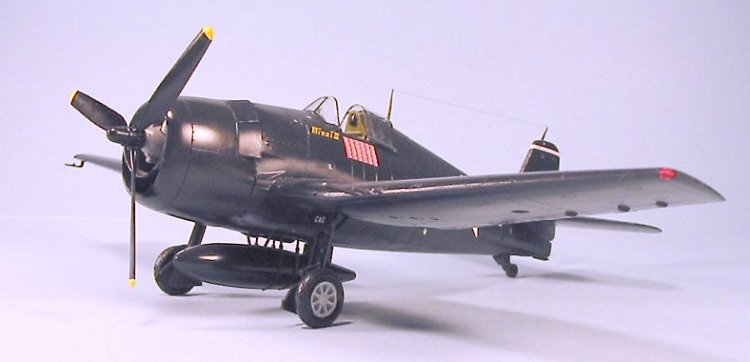
|
KIT: |
Hasegawa 1/48 F6F-5 Hellcat |
|
KIT # |
? |
|
PRICE: |
$34.95 MSRP |
|
DECALS: |
Two options |
|
REVIEWER: |
Tom Cleaver |
|
NOTES: |
Cutting Edge cowling and AeroStar decals used |

|
HISTORY |
David McCampbell - The U.S. Navy Ace of Aces:
As Alex Vraciu once put it to me in an interview, “Dave McCampbell came on the scene in May 1944 and swept all competition aside - both on his side and the Japs.”
With a final score of 34 victories, Commander David McCampbell is the U.S. Navy Ace of Aces and the all-time Number 3 U.S. ace. All his victories were scored as Commander of Air Group 15 aboard the U.S.S. Essex between mid-May and the end of October, 1944. Air Group 15 was fortunate that the timing of their tour was perfect: they appeared on the scene just in time for the First Battle of the Philippine Sea, also known as the “Marianas Turkey Shoot,” then stormed on across the Central Pacific as Admiral Halsey’s carrier-based tidal wave struck every Japanese base from Okinawa to the Philippines, with the final crescendo the Second Battle of the Philippine Sea, the greatest naval battle in history.
As with most “overnight successes,” McCampbell’s achievement was the result of a lot of hard work over ten long years; when opportunity knocked, he was fully ready to answer.
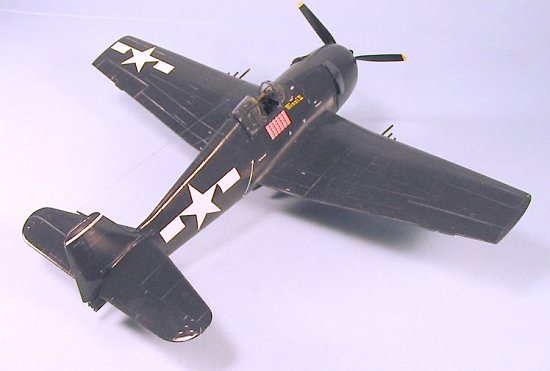 McCampbell graduated from Annapolis into the
depths of the Great Depression in 1933. He received both his diploma and
an honorable discharge on the same day from a Navy without the funds to
pay for new officers other than the top ten percent of his class.
Recalled a year later in better circumstances, McCampbell achieved his
dream of a commission as a naval officer. His first assignment involving
aircraft came in 1936 as a gunnery observer aboard the heavy cruiser
U.S.S. Portland. In 1937, his application for flight duty was
granted and he reported for a year of training at Pensacola. He won his
wings in 1938 and was assigned to VF-4, flying Grumman F3F-1s aboard
U.S.S. Ranger. In 1940, he was assigned to VF-7 aboard U.S.S.
Wasp, where he made the acquaintance of the F4F-3 and later F4F-4
Wildcat as a member of VF-71. In 1942, Wasp made two runs from
England to Gibraltar delivering Spitfires for Malta. McCampbell finally
entered combat the hard way on September 15, 1942, surviving the sinking
of Wasp by a Japanese submarine off Guadalcanal.
McCampbell graduated from Annapolis into the
depths of the Great Depression in 1933. He received both his diploma and
an honorable discharge on the same day from a Navy without the funds to
pay for new officers other than the top ten percent of his class.
Recalled a year later in better circumstances, McCampbell achieved his
dream of a commission as a naval officer. His first assignment involving
aircraft came in 1936 as a gunnery observer aboard the heavy cruiser
U.S.S. Portland. In 1937, his application for flight duty was
granted and he reported for a year of training at Pensacola. He won his
wings in 1938 and was assigned to VF-4, flying Grumman F3F-1s aboard
U.S.S. Ranger. In 1940, he was assigned to VF-7 aboard U.S.S.
Wasp, where he made the acquaintance of the F4F-3 and later F4F-4
Wildcat as a member of VF-71. In 1942, Wasp made two runs from
England to Gibraltar delivering Spitfires for Malta. McCampbell finally
entered combat the hard way on September 15, 1942, surviving the sinking
of Wasp by a Japanese submarine off Guadalcanal.
In February 1943, promoted to LCDR, McCampbell commissioned a new squadron, VF-15, as Commanding Officer. Originally equipped with the Wildcat, VF-15 began operating the F6F-3 Hellcat that summer. In February 1944, two weeks after his 34th birthday, McCampbell received promotion to Commander and command of Air Group 15, which he christened “Fabled Fifteen,” a name they would live up to. That March, the group went aboard U.S.S. Essex, arriving in the Western Pacific on May 15.
McCampbell finally entered air combat on May 19, 1944, leading a fighter sweep over Marcus Island as part of the “breaking in” process each air group was put through. Two weeks later, Essex was part of the Fifth Fleet under the command of Midway victor Admiral Raymond Spruance as the Navy prepared to seize the Marianas Islands. On June 11, flying south of Saipan, McCampbell spotted a lone Zero. Firing three short bursts, he scored his first victory. When asked about it back aboard Essex, he answered, "I knew I could shoot him down and I did. That's all there was to it."
McCampbell really
began displaying what he was made of on June 19, the first day of the
Battle of the Philippine Sea - the first carrier-vs.-carrier battle since
Santa Cruz in October 1942. That morning, the Japanese launched two
large raids against the U.S. carriers. As other fighter squadrons dealt
harshly with the first group, McCampbell and VF-15 were vectored onto the
second group - 80 Judys and Vals escorted by Zeros. At 1139 he exploded
the first Judy he spotted, then
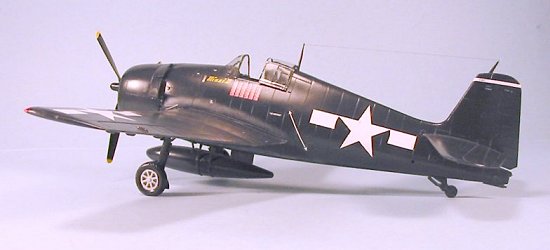 darted to the other side of the enemy
formation, where he splashed a second Judy, then scored a "probable" on a
third, followed by the dispatch of the formation leader's left wingman
and then the leader at 1144. His score of five kills and one probable in
less than five minutes was a Navy record.
darted to the other side of the enemy
formation, where he splashed a second Judy, then scored a "probable" on a
third, followed by the dispatch of the formation leader's left wingman
and then the leader at 1144. His score of five kills and one probable in
less than five minutes was a Navy record.
Launched to intercept a second raid that afternoon, he shot down a Zero, during which he became separated from his flight of eight. Returning alone to the Essex, 6,000 feet above Guam's Orote Peninsula, he saw two Zeros attack an S0C seaplane that was picking up a downed pilot. He dove on the Zeros and shot down one. LCDR George Duncan, XO of VF-15, joined up and got the other. McCampbell had set a Navy record of seven victories in one day, and a total of nine in eight days on the line.
Following the Marianas Turkey Shoot, Admiral Halsey assumed command and began the Central Pacific offensive that would end that fall in the destruction of the offensive force of the Japanese Navy. McCampbell continued to score as he led Fabled Fifteen in raids on Okinawa and Formosa, ending with strikes on Luzon September 12-13, 1944. During these air battles, McCampbell shot down five more, and nearly ended his career prematurely on the 13th. Returning alone to rendezvous after shooting down two Zeros, a Japanese Army Ki.27 Nate dove on him, fired and dove away. McCampbell dropped his belly tank applied full War Emergency Power, but couldn’t catch up. The Nate began an overhead pass, forcing McCampbell to dive for the deck. The fight became a desperate low-level dogfight at low speed with a more maneuverable opponent, and McCampbell finally escaped without a victory. In his after-action report he noted "1) Nate is even more maneuverable than Zeke. 2) Nate can out-climb F6F at 110-120 knots airspeed. 3) This 'operational student', if he was such, will have no trouble completing the course."
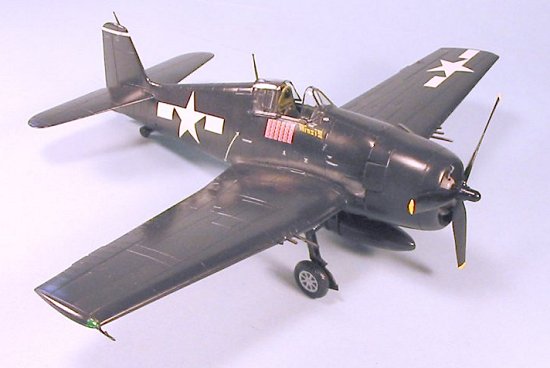 McCampbell’s
greatest day came on October 24, 1944, the opening day of the Second
Battle of the Philippine Sea.
McCampbell’s
greatest day came on October 24, 1944, the opening day of the Second
Battle of the Philippine Sea.
Task Group Commander Admiral Forrest Sherman had personally forbidden McCampbell to lead the dawn strike against the Leyte invasion zone, stating that his status as CAG and a leading Navy ace with 21 victories at the time made him “too valuable” for such a mission. At approximately 0900, with the Essex strike still away, three Japanese strike formations were detected on radar approaching the fleet from the north. The order was "All available fighter pilots! Man your planes!" McCampbell’s F6F-5, “Minsi III” was still on deck, partially fueled. Without him, Essex only had five Hellcats immediately available with which to oppose the incoming enemy. There was no time to fully fuel the Hellcat as McCampbell decided he was an “available fighter pilot” and manned his plane.
McCampbell and his wingman, Ensign Roy Rushing, applied full throttle to intercept the Japanese, then only 22 miles away. He ordered the others to get the bombers, while he and Rushing went after the escort. Surprised, the enemy fighters turned, which allowed McCampbell and Rushing to gain altitude and position behind them. Counting 40 enemy fighters below - Zeros, Tonys, Hamps, and Oscars - McCampbell radioed for help. "Sorry, none available." The enemy was in a formation of three V's. McCampbell picked out a Zero on the extreme right and flamed it, while Rushing also got one. The two Hellcats zoomed for altitude, and were amazed at the lack of response. Making a second overhead pass, McCampbell exploded a second Zero. The gaggle reacted by going into a Lufbery circle! McCampbell made two head-on passes against the formation without results.
McCampbell and Rushing regained altitude, while the Japanese continued to circle below. As he radioed again for help, the Lufbery broke up and the Japanese headed toward Luzon in a wide Vee. McCampbell and Rushing closed in again and McCampbell opened up at a distance of 900 feet, exploding his third while Rushing shot down his second.
Apparently low on fuel, the Japanese doggedly maintained formation. On his next pass, gunfire coming from behind forced McCampbell to break off his attack as he pulled up to see another Hellcat that had heard the call for help shooting too close to him. A few choice words straightened things out.
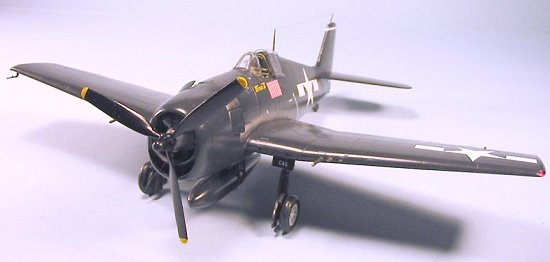 The enemy
steadfastly refused to engage. McCampbell realized he could relax and
take his time with what was virtually a gunnery exercise. He even had
time to light a cigarette and consider the situation as he realized he
still had most of his ammo! He focused on identifying his targets
carefully and perfecting his gunnery passes. The next was an Oscar, which
flamed for number four while Rushing scored his third. The two of them
continued for several more passes until Rushing radioed that he was out
of ammo, but he would stay while McCampbell used up his remaining ammo.
At this point, the CAG had a total of seven. Two more passes scored two
more kills as the enemy finally approached the security of their bases on
Luzon. Low on fuel, the Hellcats broke off and headed home to the
Essex. In one sortie, McCampbell had shot down nine enemy planes and
Rushing six, an achievement unmatched in American history.
The enemy
steadfastly refused to engage. McCampbell realized he could relax and
take his time with what was virtually a gunnery exercise. He even had
time to light a cigarette and consider the situation as he realized he
still had most of his ammo! He focused on identifying his targets
carefully and perfecting his gunnery passes. The next was an Oscar, which
flamed for number four while Rushing scored his third. The two of them
continued for several more passes until Rushing radioed that he was out
of ammo, but he would stay while McCampbell used up his remaining ammo.
At this point, the CAG had a total of seven. Two more passes scored two
more kills as the enemy finally approached the security of their bases on
Luzon. Low on fuel, the Hellcats broke off and headed home to the
Essex. In one sortie, McCampbell had shot down nine enemy planes and
Rushing six, an achievement unmatched in American history.
That afternoon, McCampbell led Air Group 15 against the main Japanese surface battle fleet in the San Bernardino Strait, during which Essex Helldivers and Avengers hit the giant battleship Musashi so badly that it sank later that night after the fleet was turned around by the American strikes. Late that afternoon, the Japanese carrier fleet was finally sighted north of Luzon. The Americans didn’t know that the Japanese plan included the sacrifice of their carriers to pull Task Force 38 away from the invasion. Believing the Japanese surface forces defeated, Halsey went for the carriers, leaving the invasion forces unprotected. The next day, off Cape Engano, McCampbell led the entire strike force of Task Force 38 against the Japanese carriers, directing his dive and torpedo bombers in the sinking of Zuikaku, last of the Pearl Harbor attackers.
Unknown to Halsey, the Japanese surface forces had turned around. As McCampbell’s fliers were sinking Zuikaku, the Japanese emerged from San Bernardino Strait with enough striking power to sink the entire U.S. invasion fleet. Fortunately for history, the fear of Halsey’s carriers after the battering his force had received the day before was so great that when the Japanese Admiral was confronted by three American destroyers and destroyer escorts desperately attacking his battleships and cruisers while aircraft from the escort carriers made fruitless strafing attacks on the heavily-armored ships, he was convinced they would only do this if the main carrier force was still in position. With the greatest victory the Japanese Navy could have scored in the entire war within his grasp, he turned and retreated from air strikes that never came.
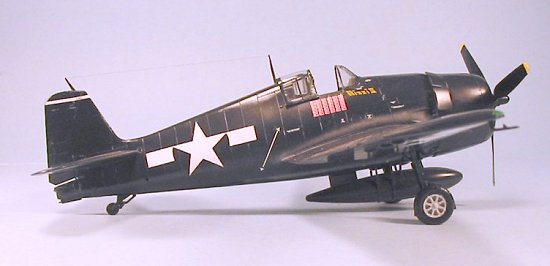 McCampbell scored
four more victories over the Philippines before Air Group 15 completed
their tour in mid-November, bringing his total score to 34. He was
awarded the Medal of Honor for the mission of October 24, 1944, and
remained in the Navy until he retired in 1964. Married four times, David
McCampbell died in Florida after a lengthy illness on June 30, 1996.
McCampbell scored
four more victories over the Philippines before Air Group 15 completed
their tour in mid-November, bringing his total score to 34. He was
awarded the Medal of Honor for the mission of October 24, 1944, and
remained in the Navy until he retired in 1964. Married four times, David
McCampbell died in Florida after a lengthy illness on June 30, 1996.
More than just an excellent fighter pilot, McCampbell’s achievement in his leadership of Air Group 15 is shown by their record: During a tour of approximately seven months, in more than 20,000 operational flying hours, the group shot down 318 enemy aircraft and destroyed another 348 on the ground, while sinking 296,500 tons of enemy ships with 580,000 tons damaged and/or probably sunk - the biggest score of any air group in the Pacific war. Among the major combat ships sunk was the battleship Musashi, the fleet carrier Zuikaku, two light carriers and a heavy cruiser. “Fabled Fifteen” more than lived up to its name as the most highly-decorated air group of the war.
McCampbell was ready to lead Air Group 15 back to the Western Pacific in August 1945, to participate in the invasion of Japan. The deployment was canceled by the atomic bombs and the surrender of Japan. Had McCampbell flown in the invasion, it is almost a certainty that he would be remembered today as the American Ace of Aces.
|
THE KIT |
Hasegawa first
released their F6F-3 Hellcat in 1995, followed shortly by the F6F-5. It
definitely showed a clean pair of heels to the earlier Otaki kit, though
any modeler who put "basics first" in their construction of the earlier
model had no reason to replace it with the newer model, since the
differences were really in the details, the most obvious being the
complete cockpit interior. The cockpit of the Hasegawa models is more
than acceptable "out of the box," though True Details has resin cockpits
for both the F6F-3 and F6F-5 which look great when installed if you’re
one who just has to have
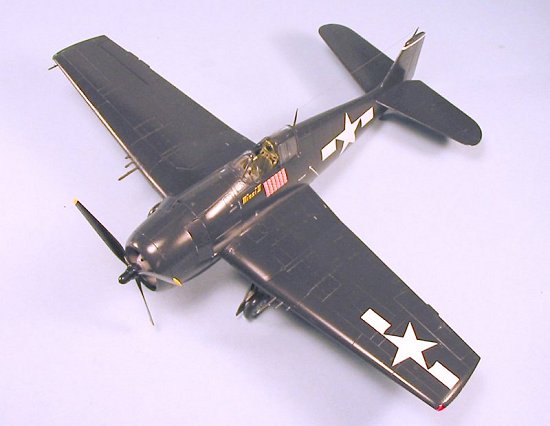 some resin inside your model. This is one of the
best of Hasegawa's 1990s kits, with none of the fit problems that plague
some of their models, like the lower wing-to-fuselage fit of the P-47
kits. If the modeler takes their time, the Hasegawa Hellcat is a "no
putty" kit.
some resin inside your model. This is one of the
best of Hasegawa's 1990s kits, with none of the fit problems that plague
some of their models, like the lower wing-to-fuselage fit of the P-47
kits. If the modeler takes their time, the Hasegawa Hellcat is a "no
putty" kit.
The one real “fault” of the Hasegawa Hellcats is that the chin of the engine cowling is not as prominent as it should be. Obscureco - using the accurate Otaki cowling as a base - has produced a very good resin replacement. Cutting Edge has also produced a resin replacement, which is molded with the large cowling flaps open. Having used the Obscureco cowling on one of my other Hellcats, I decided to use the Cutting Edge replacement for this project.
While Hasegawa provides acceptable decals for the Hellcat, there are some good aftermarket decals available. One of the great tragedies of the aftermarket was the destruction of the entire supply of AeroStar decals in 1998, due to rainwater flooding the basement they were stored in. These were very accurate decals of particular aircraft, the result of some excellent research by the designer. I was fortunate in obtaining one of each of the line at the 1998 IPMS Nationals before this event. I decided I would finally use the decals for “Minsi III,” for this project. All other personal marking decals for this airplane are inaccurate, which is pretty surprising when one notes the number of good photos of the airplane that are available. The AeroStar sheet provides the name and victory board, with the board that was on the plane immediately after his October 24, 1944 mission; the sheet provides an alternative of the 21-victory scoreboard just before the mission. Most other decals show the final victory board (with victory flags that are three times too big) which was a different airplane marked up for publicity purposes just before McCampbell returned to the United States - the original airplane having already been stripped and sent on to a Fleet Replacement Unit.
|
CONSTRUCTION |
Other than using the Cutting Edge cowling and a Falcon vacuformed canopy, the kit was built OOB. It’s impossible to build the kit with the canopy open unless one uses the vacuform canopy (also available from the same maker through Squadron). I also made seatbelts from lead foil taken from a wine bottle. (“Honey! It’s not booze! It’s modeling supplies!”)
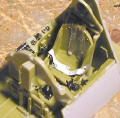 Construction
starts with the cockpit. Navy color experten William Reece and
Larry Webster both agree that Hellcats had cockpits that were painted
Interior Green - not Dull Dark Green, Grumman Green, Bronze Green, or
anything else to give a modeler fits (though the first 150 F6F-3s were
indeed painted Bronze Green). I airbrushed all the interior parts with
Gunze-Sanyo “Interior Green,” with all "black boxes" painted with Tamiya
“Semi-Gloss Black,” later dry-brushed with aluminum to bring out
details. I used the kit-supplied instrument panel decals since they are
thin and doing so is to me easier than picking out the instrument faces
with paint. All a modeler needs to do here is use Micro-Sol, and be sure
to poke holes in the decal as it dries to insure a tight fit.
Construction
starts with the cockpit. Navy color experten William Reece and
Larry Webster both agree that Hellcats had cockpits that were painted
Interior Green - not Dull Dark Green, Grumman Green, Bronze Green, or
anything else to give a modeler fits (though the first 150 F6F-3s were
indeed painted Bronze Green). I airbrushed all the interior parts with
Gunze-Sanyo “Interior Green,” with all "black boxes" painted with Tamiya
“Semi-Gloss Black,” later dry-brushed with aluminum to bring out
details. I used the kit-supplied instrument panel decals since they are
thin and doing so is to me easier than picking out the instrument faces
with paint. All a modeler needs to do here is use Micro-Sol, and be sure
to poke holes in the decal as it dries to insure a tight fit.
While the cockpit parts were drying, I painted and assembled the engine, and painted the interior of the Cutting Edge cowling light grey.
The cockpit assembles easily. Once the fuselage halves were together, the cockpit looked very realistic with the lead-foil seatbelts in position.
 I assembled the
wing per instructions, being careful to assemble so as to get a good fit
across the wing leading edge, which is one area where you can end up with
a seam ridge if you’re not careful. The lower wing carries across in one
piece, with the central lower fuselage part of the molding and the joint
being on a panel line. I carefully fitted fuselage to wing, and was
rewarded with a join line that I only had to scrape off a bit at the
forward join. So far, the kit had been assembled without putty or Mr.
Surfacer, but the lower fuselage centerline seam refused to give up
without a fight, which Mr. Surfacer 500 promptly won.
I assembled the
wing per instructions, being careful to assemble so as to get a good fit
across the wing leading edge, which is one area where you can end up with
a seam ridge if you’re not careful. The lower wing carries across in one
piece, with the central lower fuselage part of the molding and the joint
being on a panel line. I carefully fitted fuselage to wing, and was
rewarded with a join line that I only had to scrape off a bit at the
forward join. So far, the kit had been assembled without putty or Mr.
Surfacer, but the lower fuselage centerline seam refused to give up
without a fight, which Mr. Surfacer 500 promptly won.
I then attached the engine, put the exhausts into position, and then test-fitted the Cutting Edge cowling. It went on perfectly, so I attached it with cyanoacrylate.
Since everything
about the airplane other than the wheel hubs was going to be midnight
blue, I assembled the landing gear minus the main wheels and attached
them to the wing. I used the kit canopy as a "cover" for the cockpit
while painting.
|
COLORS & MARKINGS |
Painting:
The first thing I did was shoot the entire model dark grey, to check for gaps and seams, since doing a monochromatic finish guarantees any flaws will be far more apparent than they would be were there other colors to confuse the eye of the observer. There was a bit of filing and sanding still necessary on the spine of the fuselage, and just forward of the cockpit, but otherwise everything was as it should be.
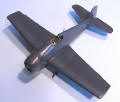 I painted the
model with Gunze-Sanyo "Midnight Blue," which I thinned 50-50 with
rubbing alcohol and applied in several thin coats, letting it dry
between, to get an overall smooth finish. As said before, a
monochromatic, shiny finish, is a killer for construction or painting
flaws. The best thing a modeler can do if they see the paint going down
wrong when doing something like this is to stop, strip the kit to bare
plastic, and start over. Fortunately, I was lucky. Once the paint had
dried thoroughly, I shot it with Future.
I painted the
model with Gunze-Sanyo "Midnight Blue," which I thinned 50-50 with
rubbing alcohol and applied in several thin coats, letting it dry
between, to get an overall smooth finish. As said before, a
monochromatic, shiny finish, is a killer for construction or painting
flaws. The best thing a modeler can do if they see the paint going down
wrong when doing something like this is to stop, strip the kit to bare
plastic, and start over. Fortunately, I was lucky. Once the paint had
dried thoroughly, I shot it with Future.
According to photos, McCampbell’s F6F-5 was an early one and used wheels with white hubs from the F6F-3. I painted these, then shot a dark wash over it to bring up detail and look like wear.
Decals:
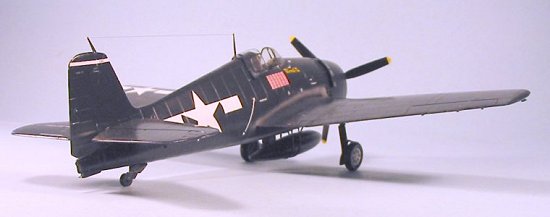 I used the
stencil markings provided in the kit decals, and then applied the
AeroStar decals. These are high-quality decals and went down with no
problems. I used national insignia from a SuperScale sheet of USN
star-and-bar insignia. I used Micro-Sol to insure everything melted into
the panel lines, which it did.
I used the
stencil markings provided in the kit decals, and then applied the
AeroStar decals. These are high-quality decals and went down with no
problems. I used national insignia from a SuperScale sheet of USN
star-and-bar insignia. I used Micro-Sol to insure everything melted into
the panel lines, which it did.
Once all was dry, I washed the model to get rid of decal setting solution, let it air-dry thoroughly, and shot it again with thinned Glosscote to get a final finish less glossy than I would have with Future.
Weathering:
The Navy adopted Glossy Sea Blue because it stood up better against salt-water corrosion than the previous paint. The finish did stay glossy, but over time it would flatten out a bit. I therefore shot a very thin coat of Testor's Dullcote over the airplane, with a bit more on the upper surfaces of the wings and horizontal stabilizer, the areas most exposed to sea spray. I gave a light exhaust stain from the four exhaust ports, using Tamiya “Sky Grey" mixed with “Smoke” and thinned 50-50 with rubbing alcohol.
|
FINAL CONSTRUCTION |
Final Assembly consisted of cutting out and attaching the Squadron vacuform canopy, which I separated and posed in the open position, and then attached the prop.
|
CONCLUSIONS |
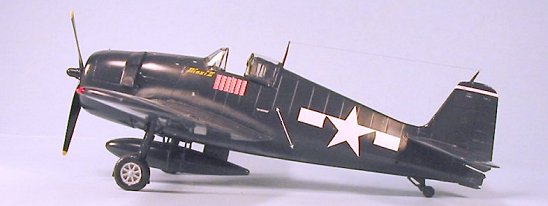 Whether you use
an aftermarket cockpit or not, Hasegawa's Hellcat is an easy project that
will look good upon completion. My only complaint about the kit out of
the box is that the canopy is too thick to pose open and look accurate.
There are a fair number of aftermarket decals for Hellcats, but the
Navy's insistence on uniformity of finish insures that outside of a few,
this is not an airplane like the Mustang with endless colorful
possibilities.
Whether you use
an aftermarket cockpit or not, Hasegawa's Hellcat is an easy project that
will look good upon completion. My only complaint about the kit out of
the box is that the canopy is too thick to pose open and look accurate.
There are a fair number of aftermarket decals for Hellcats, but the
Navy's insistence on uniformity of finish insures that outside of a few,
this is not an airplane like the Mustang with endless colorful
possibilities.
There are those who say models of aircraft flown by famous aces have been “done to death.” I disagree about that generally, but for certain this is the only model of David McCampbell’s “Minsi III” that has been done right as regards the personal markings (unless there is some unknown modeler out there also fortunate to have this sheet).
Kit courtesy of my wallet.
July 2004
If you would like your product reviewed fairly and quickly by a site that has over 250,000 visitors a month, please contact me or see other details in the Note to Contributors.